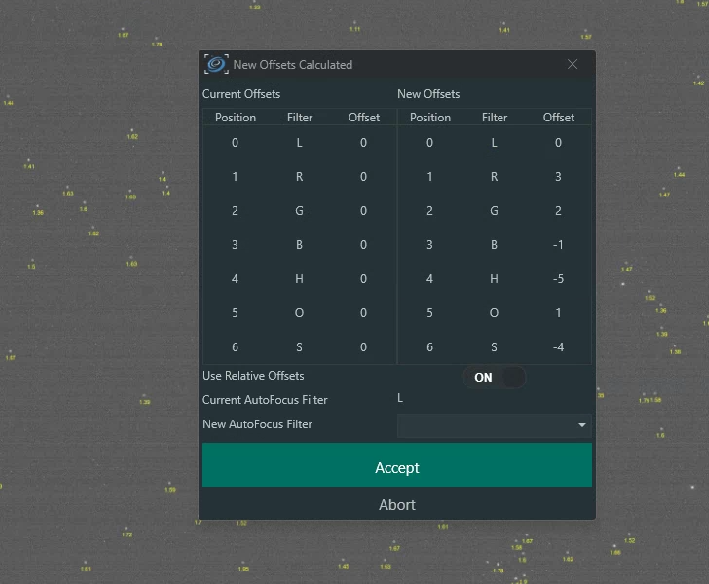I know that there is a slight focus change between narrow band filters, I can even see that shooting dual band with a refractor. When I'm focused for Ha, Oiii is slightly soft. Is the refocus when changing filters necessary only with refractors because the color correction is never perfect or is it the filter it self that's causing the shift?
The glass and coatings are different enough when switching filters that perfect focus point will move ever so slightly. It's possible though that you could have two filters that happen to have the same focus point, but that hasn't been my experience.
I don't think it's unique to refractors, and is generally probably more pronounced in faster optics that require tighter focus tolerances.
I don't think it's unique to refractors, and is generally probably more pronounced in faster optics that require tighter focus tolerances.
Well Written Helpful Respectful Concise
I don't think it's unique to refractors, and is generally probably more pronounced in faster optics that require tighter focus tolerances.
Yeah, I think I would agree here.... I think the focus change is more a physics thing... where you have light traveling in air, goes through a medium (Glass) with a different index of refraction than air, leaves the medium, back into the air traveling at some different angle than when it went in... at least that's what I remember from high school physics
Tony Gondola Topic starter
Sep 8, 2024
So, people who are using reflectors are still having to change focus with every filter? I understand the physics, just looking for real world experience.
Well Written Engaging
andrea tasselli Frequent contributor
Sep 8, 2024
No, not dual/tri/quad bands with OSCs from the same brand.
Tony Gondola:
So, people who are using reflectors are still having to change focus with every filter? I understand the physics, just looking for real world experience.
yes, I have to refocus with my reflector just as with my refractor when I switch from one band to another. This is with a mono camera, not OSC.
Concise
Tony Gondola:
So, people who are using reflectors are still having to change focus with every filter? I understand the physics, just looking for real world experience.
I surely have to with my SCT.
Even when advertised as parfocal, you always seem to need to refocus! ;-) If you use NINA, you can set up filter offsets so you don't waste a ton of time refocusing during your imaging session. Good luck and clear skies!
Norm
Norm
Well Written Insightful Respectful Concise Engaging Supportive
These are my offsets on my Takahashi E130 hyperbolic newtonian with Antilia LRGB and 3nm SHO. Not a lot when a step size is 20. Reflectors with refractive elements will still experience the same effect as refractors just not to the same degree, it might be negligible. With my RC telescopes and no refractive elements, I never refocus between filters, if I had to it would be because the filters are not truly parfocal. I have ran this routine many times on my RCs and ended up with nothing but -1 0 and 1.


Insightful
Tony Gondola Topic starter
Sep 9, 2024
Now that's really interesting, and at a fast FR. This seems to suggest that there is a difference.
Norman Tajudin:
If you use NINA, you can set up filter offsets so you don't waste a ton of time refocusing during your imaging session. Good luck and clear skies!
Agreed, I would add that there is a focus offset calculator in NINA to set this up..
There are some "best practices" for doing this.
1) Use a filter that gives you the best stars w/o hugely long exposures for the "focus filter". Most people think this is luminance but I have found that is not usually the best choice, even though that gives the most saturation and/or shortest focus exposure times. The shortest times may be fast but they also suffer more from seeing. The green filter and 4-8 second exposures almost always gives better results than luminance and one or two second exposures. Green benefits from being near the center of the visible spectrum and is typically well corrected in most systems.
2) Absolutely do many runs of the offset calculator, not just one, and figure the depth of focus for your system. Analyze the runs statistically until you are confident that your offsets have converged on a number well within the DOF band. In many cases you will see a large variation between one run of the offset calculator and another, hence the need to do multiple runs to arrive at a reliable offset.
3) Once offsets are established, you should set your focus up to take multiple samples at each point in the focus curve. How many depends on your system but typically two or three. This makes each focus statistically more stable. This does not add much time to your overall imaging and now that you are using offsets your focus times are much shorter anyway.
4) Set your allowable curve number (R2) to as high a number as you system allows (I use 90% but typically see numbers at 98 plus). If you can't get that high something needs to be fixed.
Helpful Insightful Engaging